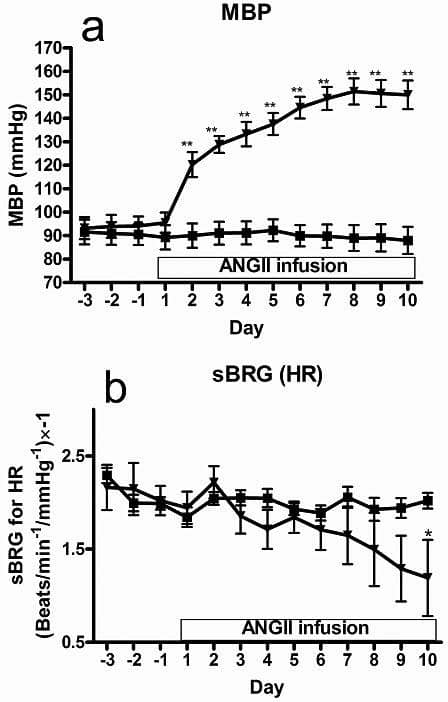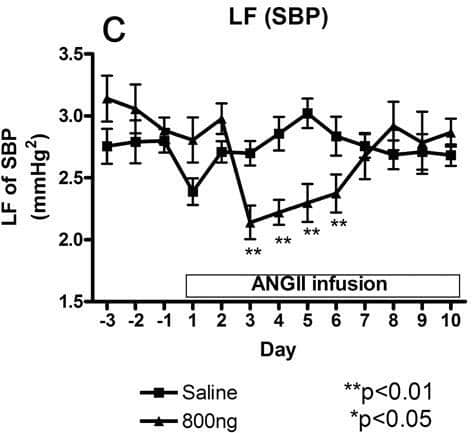In conscious rabbits renal sympathetic nerve activity is reduced during systemic infusion of a pressor dose of angiotensin II (AngII) for 7 days (Barrett et al. 2003). This was attributed to long term activation of the baroreflex. Here, we tested whether the baroreflex can be modulated in a similar manner by AngII in the Wistar-Kyoto rat, the standard normotensive control for the popular spontaneously hypertensive rat. Rats (male, 12-14 weeks; n=6) were anaesthetised with a mixture of ketamine (60 mg kg-1) and medetomidine (250 μg kg-1, both i.m.) and radio-transmitters installed for chronic measurement of arterial pressure using radio-telemetry. Continuous recordings of arterial pressure (AP) and heart rate (HR) were made for 3 days prior to, and 10 days during, osmotic minipump driven infusion of Ang II (800ng/kg/min; s.c.). Hey Presto software (Waki et al. 2006) was used to evaluate AP and heart rate as well as their power spectra so that changes in autonomic cardiovascular activity could be assessed. The spontaneous cardiac baroreceptor reflex (sBRG) was also computed. AngII produced a persistent elevation of mean AP (from 94±4 to 151±6 mmHg by day 8, mean ± S.E.M; Fig. 1a) associated with increased drinking. There was an immediate decrease in HR from 366±5 to 262±7 bpm on day 2 (P<0.01; one-way ANOVA). However, from day 3, HR increased gradually so that by day 9 it was higher than before the infusion (406±18 bpm; P<0.05) and continued to increase until the end of the experiment on day 10 (425±10 bpm, P<0.01). The high frequency power of pulse interval (HF of PI;an index of cardiac vagal activity) followed a similar temporal pattern to that of the HR: initially it increased from 15.9±1.0 pre-infusion to 40.5±1.9 ms2 (P<0.01) on day 2 and then decreased for the remainder of the recording period. The sBRG remained unchanged until day 5 and by day 10 it was significantly depressed (Fig 1b; -2.1±0.1 pre-infusion vs -1.2±0.4 beats min-1 mmHg-1; P<0.05). Finally, the low frequency (LF) component of the spectra of systolic blood pressure (an index of the sympathetic vasomotor activity) was depressed from day 3 to 6 of the AngII infusion (3.0±0.1 pre-infusion vs 2.1±0.1 mmHg2 on day 3; P<0.01) but then returned to control levels by day 7 where it remained (Fig 1c). These data suggest that in the rat chronic infusion of AngII causes a sustained increase in blood pressure that is accompanied by a relatively transient baroreflex mediated bradycardia and sympathoinhibition. However, by day 7 the parasympathetic component of the baroreflex fails and sympathetic vasomotor activity increases to control levels. These data suggest that chronically increased peripheral levels of AngII may cause hypertension not only via the classical actions of peripheral vasoconstriction and water retention but also via central modulation of the baroreflex, which is consistent with our earlier data (Paton & Kasparov 1999).
University College London 2006 (2006) Proc Physiol Soc 3, PC86
Poster Communications: Delayed failure of baroreflex function caused by chronic infusion of angiotensin II in a normotensive rat
Marie Ann Toward1, Sergey Kasparov1, Julian F.R. Paton1
1. Physiology, University of Bristol, Bristol, United Kingdom.
View other abstracts by:
Figure 1. Cardiovascular effects of chronic AngII infusion.
Where applicable, experiments conform with Society ethical requirements.


